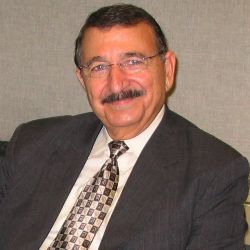|
|
Biography |
|
|
 He Received his B.Sc. at Ain Shams U. Cairo, Egypt; Ph.D., at Florida State University; Postdoctoral Fellow at Yale, Harvard and the California Institute of Technology. He was a Chemistry Faculty member at (1961-94) and Julius Brown Chair and Regents’ Professor at Georgia Institute of Technology (1994-present). El-Sayed published over 600 publications in the fields of molecular dynamics, energy conversion, photobiology, laser spectroscopy and lately Nano-technology. The citations to his work in the last decade placed him fourth in the field of Academic Chemistry World-wide.
El-Sayed is an Elected Member of the US National Academy of Sciences , an Elected Fellow of the American Academy of Arts and Sciences , an Elected Associate Member of TWAS; an Inaugural Fellow of theACS, the APS and an Elected Fellow of the AAAs. He is an Honorary Fellow of the Indian and of the Chinese Chemical Societies.
El-Sayed was an Alexander von Humboldt Senior Fellow, Germany, a Visiting Professor at the University of Paris, an Alfred P. Sloan as well as a Guggenheim Foundation Fellow, a Fairchild Fellow at the California Institute of Technology and a Miller Visiting Professor at U.C. Berkley
He received the King Faisal International Prize in the Sciences; an honorary Doctor Degrees from the Colleges of Medicine of both Mansoura and Alexandria Universities in Egypt and recently from the American University of Beirut. He has received a number of national awards such as the Fresenius, the Tolman, the Richard’s medal, the Lindeman’s medal, the Seaborg’s medal as well as other numerous local sectional awards. In 2002, he received the ACS-APS Langmuir National Award in Chemical Physics and in 2007 was the Georgia Tech’s distinguished Professor of the year. Professor El-Sayed received the 2007 USA National Medal of Science in Chemistry from the President of the United States (2008) and the Medal of the Egyptian Republic of the First Class (2009).
He Received his B.Sc. at Ain Shams U. Cairo, Egypt; Ph.D., at Florida State University; Postdoctoral Fellow at Yale, Harvard and the California Institute of Technology. He was a Chemistry Faculty member at (1961-94) and Julius Brown Chair and Regents’ Professor at Georgia Institute of Technology (1994-present). El-Sayed published over 600 publications in the fields of molecular dynamics, energy conversion, photobiology, laser spectroscopy and lately Nano-technology. The citations to his work in the last decade placed him fourth in the field of Academic Chemistry World-wide.
El-Sayed is an Elected Member of the US National Academy of Sciences , an Elected Fellow of the American Academy of Arts and Sciences , an Elected Associate Member of TWAS; an Inaugural Fellow of theACS, the APS and an Elected Fellow of the AAAs. He is an Honorary Fellow of the Indian and of the Chinese Chemical Societies.
El-Sayed was an Alexander von Humboldt Senior Fellow, Germany, a Visiting Professor at the University of Paris, an Alfred P. Sloan as well as a Guggenheim Foundation Fellow, a Fairchild Fellow at the California Institute of Technology and a Miller Visiting Professor at U.C. Berkley
He received the King Faisal International Prize in the Sciences; an honorary Doctor Degrees from the Colleges of Medicine of both Mansoura and Alexandria Universities in Egypt and recently from the American University of Beirut. He has received a number of national awards such as the Fresenius, the Tolman, the Richard’s medal, the Lindeman’s medal, the Seaborg’s medal as well as other numerous local sectional awards. In 2002, he received the ACS-APS Langmuir National Award in Chemical Physics and in 2007 was the Georgia Tech’s distinguished Professor of the year. Professor El-Sayed received the 2007 USA National Medal of Science in Chemistry from the President of the United States (2008) and the Medal of the Egyptian Republic of the First Class (2009).
|
|
|
|
|
|
|
Abstract |
|
|
|
|
Some of the Scientific Wonders on the Nano-meter scale |
|
|
|
|
|
The properties of the material we use in our everyday life like color, scattering, melting temperature, strength or conductivity all depend on the space their electrons has to execute their characteristic motion. In different materials, this space varies between one and a hundred nanometers (the thickness of one human hair is 50,000 nanometers). Thus if we reduce the size of any material below its characteristic size, we obtain new materials of different shapes each with completely new properties. Some of these new properties can be used for human needs thus have the potential to expand the industrial production in the World. Nanotechnology has already expanded in different fields and is predicted to expand its industrial worth to the trillions of dollars by the year 2015.
Gold is an example. As a metal, it is chemically uncreative with only strong and stable decorative luster. When it is prepared in the small nanometer size of different shapes, it acquires properties useful in many fields such as sensing, enhancing solar energy conversion, electronics, in biology and medicine with uses in diagnostics, in more than one way to destroy cancer cells and in drug delivery.
The small size of the nano-gold or nano-silver particles as well as their strong scattering properties enabled us to bind either one to any part of the cell and image its change in time during the cell cycle. When either binds to the nucleus of a cancer cell, they kill the cell. We were able to image in time (using video) the death of a cancer cell and the behavior of the surrounding bystander cells as one cell dies. From the observed time dependent behavior of the cells upon death and their surrounding cells, the death mechanism of the cancer cells by the two particles can be concluded. |
|
|
|
|